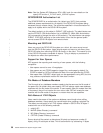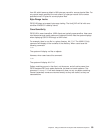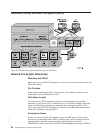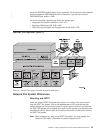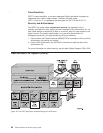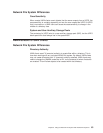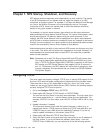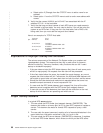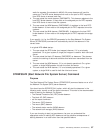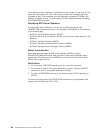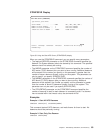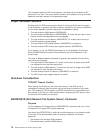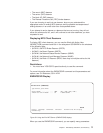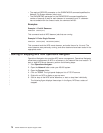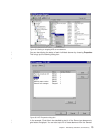
a. Select option 2 (Change) from the CFGTCP menu to add a name for an
address.
b. Select option 1 from the CFGTCP menu to add an entire new address with
names.
6. Verify that the names LOOPBACK and LOCALHOST are associated with the IP
address 127.0.0.1 in the host table.
7. Verify that the long and short names of each NFS server you need access to
are included in the host table. You only need to do this if you will be using the
system as an NFS client. If they are not in the host table, and a DNS is not
being used, then you must add the long and short names.
Here is an example of a TCP/IP Host table:
Internet Host
Opt Address Name
19.45.216.4 THISHOST
THISHOST.COMPANY.DOM1.COM
19.45.216.93 NFSSERV1
NFSSERV1.COMPANY.DOM1.COM
127.0.0.1 LOOPBACK
LOCALHOST
Implications of Improper Startup and Shutdown
The various components of the Network File System make up a complex and
interdependent system. This means that they rely on each other for common,
efficient functioning. There are, therefore, many functions that can fail if users
startup or shutdown improperly:
v If the user does not start the RPC binder daemon first, then all local server ports
will fail to map properly. No requests from the client will be processed.
v If the client starts before the server has loaded the mount daemon, any mount
requests the client makes will fail. Furthermore, the NLM and NSM daemons will
not be able to grant locks until users start them on both the client
and
the server.
v Should the client be started and make mount requests before the server has
issued the export command, all mount requests will fail.
v If a user ends the RPC binder daemon (port mapper) first, then all the other
daemons cannot unregister with the RPC binder (port mapper) daemon.
v If users do not end all the daemons, then there can be confusion on the next
startup of which daemons are operating and which are not.
Proper Startup Scenario
In a typical NFS server startup:
1. The user starts the RPC binder (port mapper) daemon (QNFSRPCD). This
daemon then waits on a known port (#111) for local RPC requests to register a
service. This daemon also waits for remote RPC requests to query a local
service.
2. The user calls the export command, creating a list of exported directories in the
export table from information contained in the /etc/exports file.
3. The user starts the NFS server daemon (QNFSNFSD) or daemons. It registers
to the local RPC binder daemon, which knows on which port the NFS server
66 OS/400 Network File System Support V4R4
|
|
|
|
|
|
|
|
|
|
|
|
|
|
|
|
|
|
|
|
|



